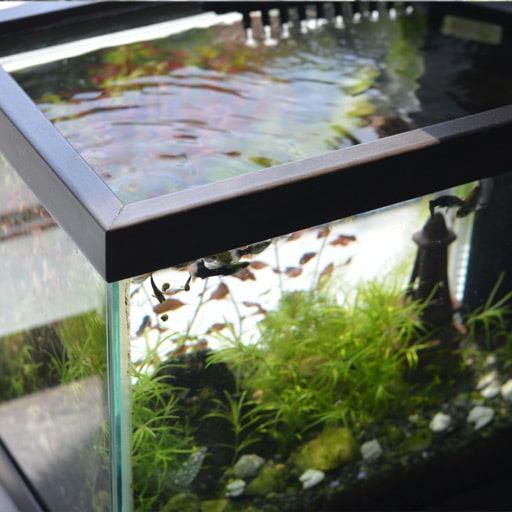A Simple Guide On Starting A Fish Tank For beginners
Welcome to FishTankFAQ.com, where I, love to help beginners like you dive into fishkeeping with confidence. In this simple guide on starting a fish tank for beginners I’m going to cove things like “What size tank is best?” or “How do I keep the water clear?”A lot this can feel a little overwhelming. I’ve been there, making rookie mistakes like overfeeding my first betta or skipping tank cycling. This ultimate guide for 2025 walks you through every step to set up a thriving aquarium, from choosing the right tank to maintaining crystal-clear water.
Some links in this post are affiliate links, meaning I may earn a commission at no cost to you. See my Affiliate Disclosure for details.
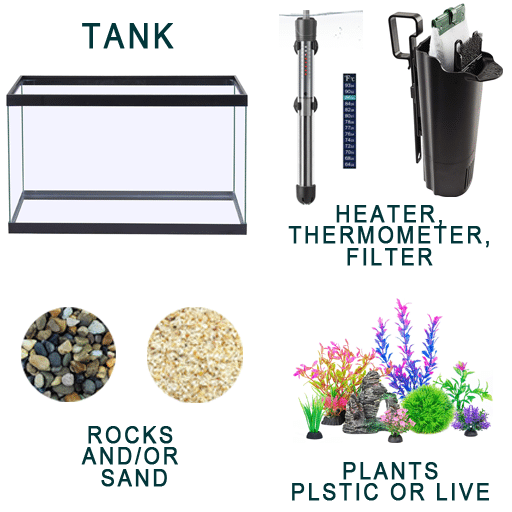
Why Start a Fish Tank?
An aquarium brings a calming slice of nature into your home, whether it’s a vibrant betta tank, a community of neon tetras, or a unique jellyfish setup. Fishkeeping reduces stress, enhances decor, and is more accessible than you might think. As a beginner, you’ll face challenges, but with the right setup, you can avoid pitfalls I learned the hard way—like neglecting water tests or overcrowding my tank. This guide covers choosing a tank, picking a location, setting up equipment, cycling, selecting fish, adding plants, and maintenance, answering common questions to ensure your aquarium thrives in 2025.
Step 1: Choose the Right Aquarium Size
Selecting the right tank size is critical for beginners. Smaller tanks (e.g., 5 gallons) seem easier but are harder to maintain due to unstable water parameters, while larger tanks dilute waste better, simplifying care.
- Recommended Sizes: A 10–20-gallon tank is ideal for beginners, balancing ease and flexibility. A 10-gallon kit like the Aqueon 10-Gallon Aquarium Kit is compact and affordable (~$100–$125), while a 20-gallon offers more fish options (~$175–$200).
- Why Size Matters: Larger volumes stabilize pH, ammonia, and nitrate levels, reducing maintenance. A 10-gallon tank weighs ~100 lbs when full, and a 20-gallon weighs ~200 lbs, so check your space.
- Tips: Measure your space (e.g., a 10-gallon is ~20”L x 10”W x 12”H). Budget for accessories like filters and heaters. My advice would be to avoid tanks under 5 gallons due to water quality challenges, but they can be fun and fairly easy.
If you want to make all this simplier, get a complete aquarium kit! An all in one get takes the guess work out what heater and filter to get while still being able to style your tank anyway you like.
Shop Complete Fish Tanks At Amazon
Step 2: Pick the Perfect Tank Location
Choosing the right location for your aquarium prevents issues like algae growth, temperature swings, or structural damage.
- Ideal Location: Place on a sturdy, level stand (e.g., Marineland Aquarium Stand) away from direct sunlight (to reduce algae) and heat sources like radiators (avoids temperature fluctuations). A 20-gallon tank weighs ~200 lbs, so ensure your floor or furniture can support it.
- Considerations: Ensure access to power outlets for equipment (filter, heater, lighting). Avoid high-traffic areas to minimize fish stress and accidental bumps. Keep away from windows or air vents to maintain stable conditions.
- Setup Tips: Use a leveling mat under the stand for stability. If possible, place your tank near a water source for easy water changes.
- Troubleshooting: If algae grows due to sunlight, you may need to relocate the tank or use blackout curtains if possible. If temperature fluctuates, adjust heater placement inside the tank. Check out our guide on how to get clear water in your tank.
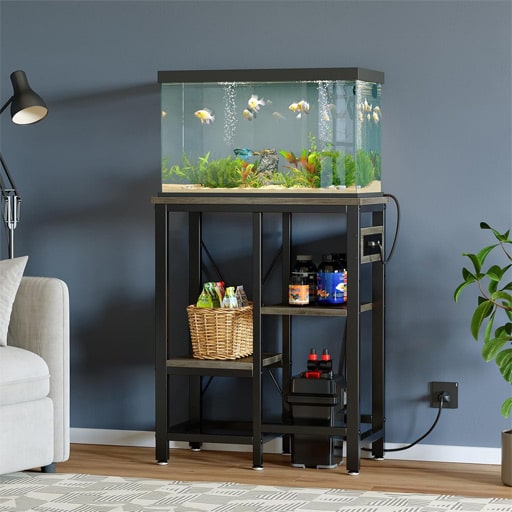
Shop Aquarium and Fist Tank Stands At Amazon
Step 3: Understand Aquarium Types
Aquariums come in three main types: freshwater, saltwater, and brackish, each with unique requirements. Freshwater is best for beginners due to its simplicity and affordability.
- Freshwater: Easy to maintain, supporting hardy fish like guppies, tetras, or bettas. Equipment costs are low (~$50–$150 for a 10-gallon setup). Ideal for beginners.
- Saltwater: Visually stunning but complex, requiring advanced equipment like protein skimmers and precise salinity control. Nano reef kits like Fluval Sea Evo XII are beginner-friendly for saltwater.
- Brackish: A hybrid for specific fish like puffers, blending fresh and saltwater. Less common for beginners due to specialized needs.
- Specialty Tanks: Unique setups like jellyfish tanks require expertise and specific equipment.
Pro Tip: Start with a freshwater tank to master basics before exploring saltwater or specialty setups like jellyfish or nano reefs.
Step 4: Budget for beginners starting a fish tank
Planning your budget prevents surprises and ensures a successful setup. Here’s a detailed breakdown for a 10-gallon freshwater aquarium:
| Tank | $35 and up | Shop Tanks on Amazon |
| Stand | $40 and up | Shop Stands on Amazon |
| Filter | $15 and up | Shop Fish Tank Filters on Amazon |
| Heater | $15 and up | Shop Aquarium Heaters on Amazon |
| Lighting | $20 and up | Shop Fish Tank Lights on Amazon |
| (Substrate) Gravel or/and Sand | $10 and up | Shop Substrate on Amazon |
| (Decor) Plants, drfitwood, ect | $5 and up | Shop Aquarium Decor on Amazon |
| Fish | $10 and up | Go to Pet Store |
| Fish Food | $3 and up | Shop Fish Food on Amazon |
| (Maintenance Supplies) Scrapers, nets, vacuums, test kits, conditioner, ect. | $15 and up | Shop Fish Tank Maintenance Supplies on Amazon |
| (Optional) Algae Control | $5 and up | Shop Algae Control on Amazon |
| Total | $173 +/- based on average costs for 10 gallon tank and gear | Save with sales or complete fish tank kits |
| 10 Gallon Complete Fish Tank Kits | Start at around $75 | Shop Complete Fish Tank Kits on Amazon |
Step 5: Set Up Your Equipment
A fish tank needs essential equipment to keep fish healthy. Here’s a detailed guide to each component, with comparisons and troubleshooting tips:
Filters
Removes waste, debris, and toxins to maintain water clarity. Hang-on-back (HOB) filters like AquaClear 20 (100 GPH, around $35) are ideal for 5–20-gallon tanks, offering mechanical, chemical, and biological filtration. Choose a filter with 4–5x tank volume per hour (e.g., 40–100 GPH for 10 gallons).
Setup: Place on tank rim, ensure tubing is secure. Prime with tank water.
Troubleshooting: If water flow slows, rinse filter media in tank should take care of the problem. It’s is best to do this at least monthly. See our guide to the best filters for aquariums
Heaters
Maintains stable temperatures (75–80°F for most freshwater fish). The Eheim Jager 50W ( about $25) is reliable for 10-gallon tanks, with adjustable settings. Compare to Aqueon Preset Heater 50W ( around $20). Place near filter outflow for even heat distribution.
Troubleshooting: If temperatures fluctuate, check wattage (it’s best to go with 5Watts per gallon of your tank. So a for a 10 gallon go with at least 50Watts, 20 gallon 100watts) or reposition heater.
Lighting
Enhances aesthetics and supports fish/plants. The NICREW ClassicLED ( about $20) is adjustable for 10–20-gallon tanks, with day/night modes. Compare to Aqueon Clip-On LED ( about $15, smaller tanks). Limit to 8–10 hours daily to prevent algae.
Troubleshooting: If algae grows, reduce light duration or use a timer like BN-LINK Digital Timer.
Substrate (Gravel and/or Sand)
Gravel or sand adds beauty and supports plants. Use 1–2 lbs per gallon (e.g., CaribSea Super Naturals Gravel about $15 for 10 lbs). Compare to Fluval Plant and Shrimp Stratum ( about $20, plant-friendly). Always rinse off whatever substrate you are going to before adding it to the tank.
Troubleshooting: If water clouds, rinse substrate more thoroughly or use a clarifier.
Test Kits
Monitors pH, ammonia, nitrite, and nitrate. The API Master Test Kit (about $30) is accurate for weekly testing. Compare to Tetra EasyStrips (about $10, faster but less precise).
Troubleshooting: If you water pH is high, you can adjust it with something like API pH Down. Check out our guide on How To Bring Down pH Easily
Thermometer
Tracks temperature. Use a Zacro LCD Digital Thermometer ( about $10) for accuracy.
Troubleshooting: If readings vary, calibrate or replace with a new unit.
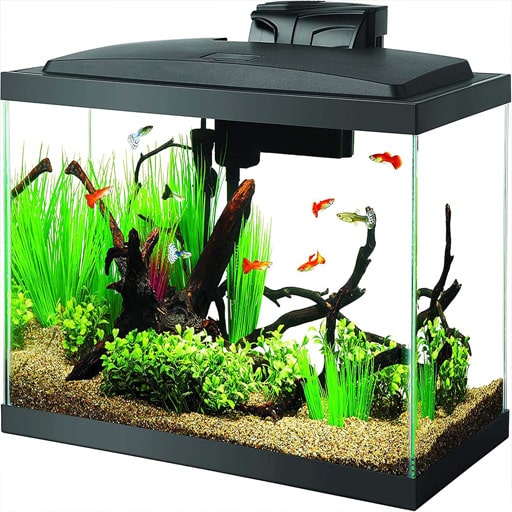
Step 6: Add Live Plants (optional)
Live plants enhance aesthetics, improve water quality, and provide fish habitat. They’re beginner-friendly with the right choices.
- Best Plants: Java fern, Anubias, and Amazon sword thrive in low light and gravel/sand substrates. Use Fluval Plant and Shrimp Stratumfor root plants. See Can Aquarium Plants Grow in Sand [internal link].
- Setup: Attach Java fern to driftwood with Seachem Flourish Glue . Plant Amazon sword in substrate (1–2 inches deep).
- Care: Use low light (8 hours daily) and add Seachem Flourish for nutrients. Avoid aquarium salt with sensitive plants.
- Troubleshooting: If plants yellow, check light or nutrients. Trim dead leaves with Aquascaping Scissors.
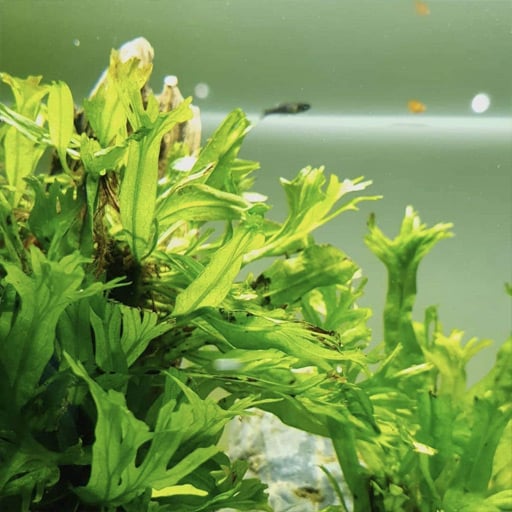
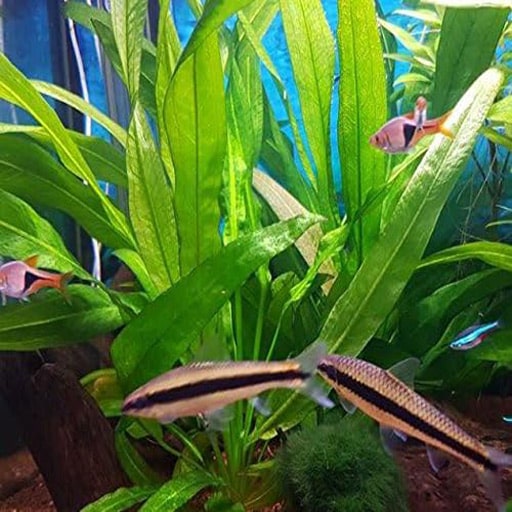
Step 7: Choose Beginner-Friendly Fish
Selecting hardy fish prevents early losses. Here are detailed profiles for beginner fish in 5–20-gallon tanks:
- Betta: Vibrant, low-maintenance, ideal for 5–10 gallons. One per tank due to aggression. Feed BettaMin Flakes and use Bettafix ( about $8) for health issues. Needs warm water (78–82°F).
- Guppies: Colorful, peaceful, breed easily. Stock 5–8 in a 10-gallon tank. Feed TetraMin Flakes. Hardy in 75–82°F.
- Neon Tetras: Bright, schooling fish; need 6–10 in a 10–20-gallon tank. Feed small amounts daily. Thrive in 70–78°F.
- Corydoras: Peaceful bottom-dwellers; stock 4–6 in a 20-gallon tank. Use sinking pellets like Hikari Sinking Wafers ( about $5).
- Stocking Scenarios:
- 10-Gallon: 1 betta + 5 neon tetras or 6–8 guppies.
- 20-Gallon: 6 neon tetras + 4 corydoras + 5 guppies.
- Rule: 1 inch of adult fish per gallon (e.g., 10 inches for 10 gallons).
- Feeding: Feed 1–2 times daily, removing uneaten food after 2 minutes.
- Troubleshooting: If fish gasp or hide, test water for ammonia or pH issues. Adjust with API Stress Coat (about $8).
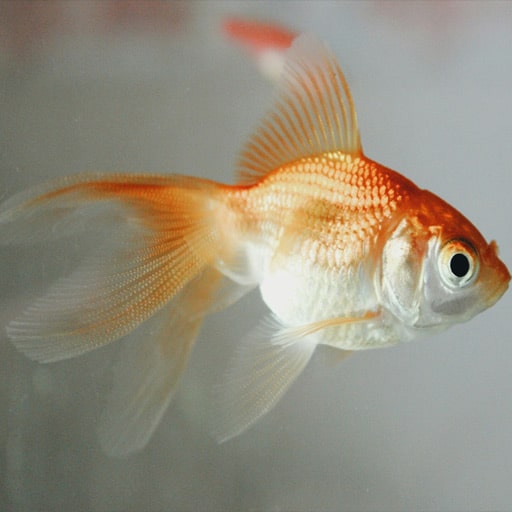
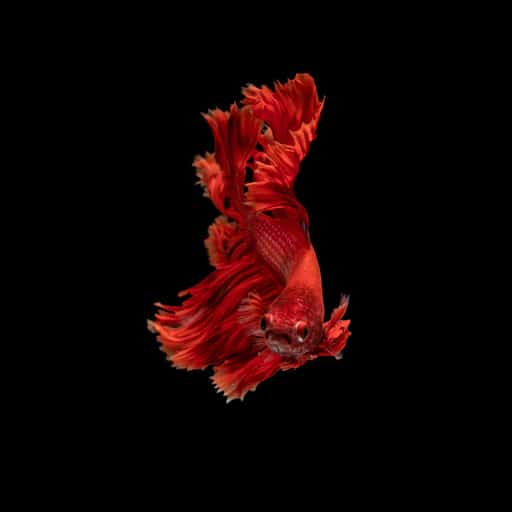
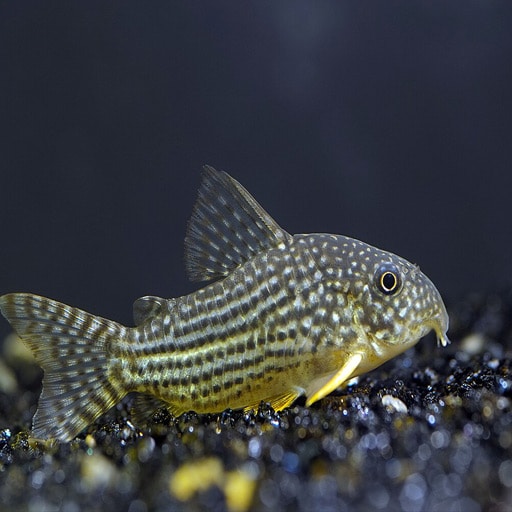
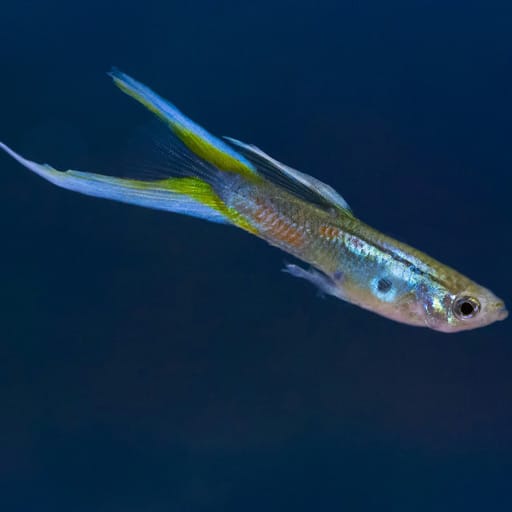
Step 8: Maintain Your Tank
Regular maintenance ensures a healthy aquarium and clear water. Here’s a detailed maintenance routine:
- Water Changes: Replace 25% of water weekly using API Tap Water Conditioner (about $8) to remove chlorine. Use a Aqueon Siphon Vacuum (about $10) for easy gravel cleaning.
- Tip: Test water before changes to monitor parameters. How to bring down pH in your tank
- Tip: Test water before changes to monitor parameters. How to bring down pH in your tank
- Filter Cleaning: Rinse filter media monthly in tank water to preserve bacteria. Replace carbon every 3–4 months. Check our our simple guide that covers Best fish tank filters
- Algae Control: Scrape glass weekly with API Algae Scraper (about $7). Add algae-eaters like nerite snails if needed.
- Water Clarity: Use clarifiers like Seachem Clarity ( about $10) for cloudiness. For persistent algae, consider a UV sterilizer.
- Troubleshooting: If water clouds, test for ammonia or overfeeding. If algae persists, reduce light to 8 hours or add live plants (see Step 6).
See Our Guide on How to Make Water Clear Quickly
Common Mistakes For Beginners When Starting A Fish Tank
Avoid these pitfalls to ensure a thriving aquarium:
- Overfeeding: Clouds water and spikes ammonia. Feed sparingly, 1 or 2 times daily.
- Wrong Tank Size: Tanks under 5 gallons are unstable.
- Ignoring Water Parameters: High pH or ammonia harms fish. Test weekly and adjust as needed. See our post on lowering pH easily.
- Overstocking: Crowding spikes toxins. Stick to 1 inch of fish per gallon.
- Adding Plants Incorrectly: Some substrates or salt harm plants.
- Poor Location: Sunlight or unstable surfaces cause issues. See Step 2 for location tips.
Starting A Fish Tank For Beginners FAQs
Here are answers to common beginner questions, based on my experience and insights from online communities
Q: How much does a beginner fish tank cost?
A: A 10-gallon setup costs ~$145–$310, including tank, stand, filter, heater, substrate, fish, and maintenance supplies. Budget kits like Tetra 10-Gallon Complete Kit start at around $75.
Q: Can I add live plants to my tank?
A: Yes, beginner-friendly plants like Java fern, Anubias, or Amazon sword thrive in gravel or sand. Avoid salt with sensitive plants.
Q: How do I keep my tank low-maintenance?
A: Choose hardy fish (e.g., guppies), a reliable HOB filter, and test water weekly with API Master Test Kit. Regular 25% water changes help.
Q: What’s the best way to keep water clear?
A: Perform 25% water changes weekly, use a good filter, and add clarifiers like Seachem Clarity. For algae build up, consider a UV sterilizer. See our simple guides on how to make fish tank water clear and best aquarium filters for beginners.
Q: How long does it take to set up a tank?
A: Physical setup takes 1–2 days, but cycling requires 4–8 weeks. You can use Seachem Stability to help speed cycling.
Q: How much gravel do I need for my tank?
A: Use 1–2 lbs per gallon (e.g., 10–20 lbs for a 10-gallon tank). Rinse thoroughly before adding to avoid cloudiness.
Q: Can I add decorations to my tank?
A: Yes, use aquarium-safe decorations like rocks, driftwood, or resin caves.
Q: Can I mix different fish in my tank?
A: Yes, but choose compatible species (e.g., guppies and neon tetras). Avoid aggressive fish like cichlids with bettas. Stock 1 inch per gallon. With a 10 gallon tank you could have five 2 inch fish, two 5 inch fish, or ten one inch fish.
Q: How do I acclimate fish to my tank?
A: Float the fish bag in your tank for 15–20 minutes to match temperature, then slowly mix tank water into the bag over 30 minutes. Use a net to transfer fish. Add something like API Stress Coat to reduce stress.
Q: How do I know if my tank is overstocked?
A: If ammonia or nitrite rises above 0 ppm, or fish show stress (gasping, lethargy), you may have too many fish. Stick to 1 inch per gallon and test regularly with API Master Test Kit.
Get Started Today
You’re ready to launch your fish tank adventure with confidence! From picking the perfect 10–20-gallon tank to choosing hardy fish like bettas or guppies. With tips on finding a stable location, setting up equipment like filters and heaters, cycling your tank, adding live plants, and maintaining crystal-clear water, this guide simplifies fishkeeping for beginners. Avoid common pitfalls like overfeeding or skipping water tests to keep your tank vibrant. If you’ve got questions, drop them in the box down below or send me a message on the contact page.
- How Much Aquarium Gravel Do I Need for a Beginner Tank? - October 13, 2025
- Best Aquarium Testing Kit: A Complete Guide - September 27, 2025
- What Are the Best Aquarium Filters? - July 8, 2025

